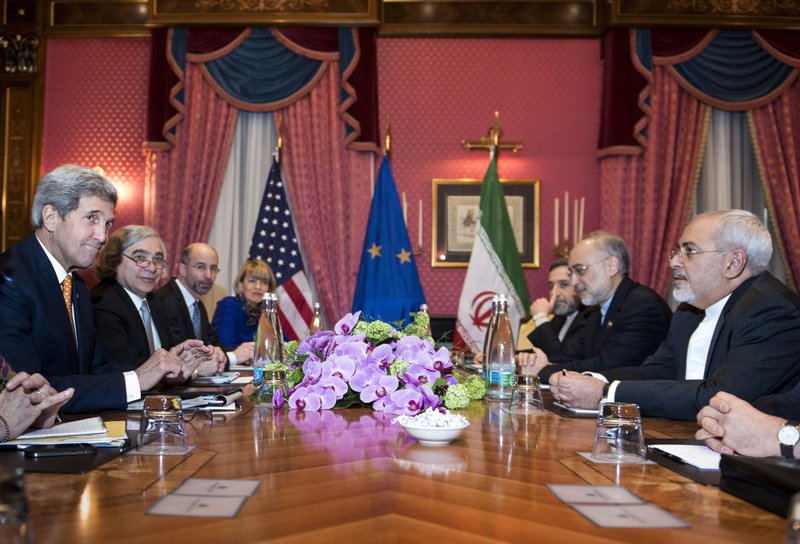LAUSANNE, Switzerland -- The United States is considering letting Tehran run hundreds of centrifuges at a once-secret, fortified underground bunker in exchange for limits at other sites on centrifuge work and research and development , officials said.
The trade-off would allow Iran to run several hundred of the devices at its Fordo facility, although the Iranians would not be allowed to do work that could lead to an atomic bomb and the site would be subject to international inspections, Western officials familiar with the negotiations said.
In return, Iran would be required to scale back the number of centrifuges it runs at its Natanz facility and accept other restrictions on nuclear-related work.
Instead of uranium, which can be enriched to be the fissile core of a nuclear weapon, any centrifuges permitted at Fordo would be fed elements such as zinc, xenon or germanium to separate out isotopes used in medicine, industry or science, the officials said.
The officials spoke only on condition of anonymity because they were not authorized to discuss details of the negotiations as the latest round of talks began between U.S. Secretary of State John Kerry and Iranian Foreign Minister Mohammad Javad Zarif.
The negotiators are racing to meet an end-of-March deadline to reach an outline of an agreement that would grant Iran relief from international sanctions in exchange for curbing its nuclear program. The deadline for a final agreement is June 30.
The officials stressed that the potential compromise on Fordo is just one of several options on a menu of highly technical equations being discussed in the talks. All of the options are designed to keep Iran at least a year away from producing an atomic weapon for the life of the agreement, which will run for at least 10 years.
Even if uranium were used, the number of centrifuges at Fordo would not be enough to enrich the amount of uranium needed to produce a weapon within a year, the officials said.
Experts said the compromise for Fordo could still be problematic. They note it would allow Iran to keep intact technology that could be quickly repurposed for uranium enrichment at a sensitive facility that the U.S. and its allies originally wanted stripped of all such machines -- centrifuges that can spin uranium gas into uses ranging from reactor fuel to weapons-grade material.
And the issue of inspector access and verification is key. Iran has resisted "snap inspections" in the past.
Even as the nuclear talks have made progress, Iran has yet to satisfy questions about its past possible nuclear-related military activity. The fact that questions about such activity, known as Possible Military Dimensions, remain unresolved is a serious concern for the U.N. atomic watchdog.
In addition, the site at Fordo is a particular concern because it is hardened and dug deeply into a mountainside, making it resistant -- possibly impervious -- to air attack. Such an attack is an option that neither Israel nor the U.S. has ruled out in case the talks fail.
Washington has taken the main negotiating role with Tehran in talks that formally remain between Iran and six world powers, and officials said last week that the two sides were zeroing in on a cap of 6,000 centrifuges at Natanz, Iran's main enrichment site.
That's fewer than the nearly 10,000 Tehran now runs at Natanz yet substantially more than the 500 to 1,500 that Washington originally wanted as a ceiling. Only a year ago, U.S. officials floated 4,000 as a possible compromise.
One of the officials said discussions focus on an extra 480 centrifuges at Fordo. That would potentially bring the total number of machines to nearly 6,500.
Kerry, Zarif and their teams huddled Thursday in the Swiss resort town of Lausanne to try to bridge the gaps after nearly two years of negotiations between Iran and the five permanent members of the U.N. Security Council and Germany.
The top diplomats from Britain, China, France, Germany and Russia are expected to join the talks if the U.S. and Iran are close to an agreement.
If a breakthrough isn't reached by the Tuesday deadline, American lawmakers have threatened new sanctions on Iran, as well as the establishment of a process that would allow them to vote down any final accord.
Ali Akbar Salehi, Tehran's top nuclear official, said the talks have already reached a "common understanding" on technical issues. Salehi, who also is at the talks, added he was optimistic that a comprehensive deal was also within reach.
Information for this article was contributed by Bradley Klapper, Ali Akbar Dareini, George Jahn and Sylvie Corbet of The Associated Press.
A Section on 03/27/2015
